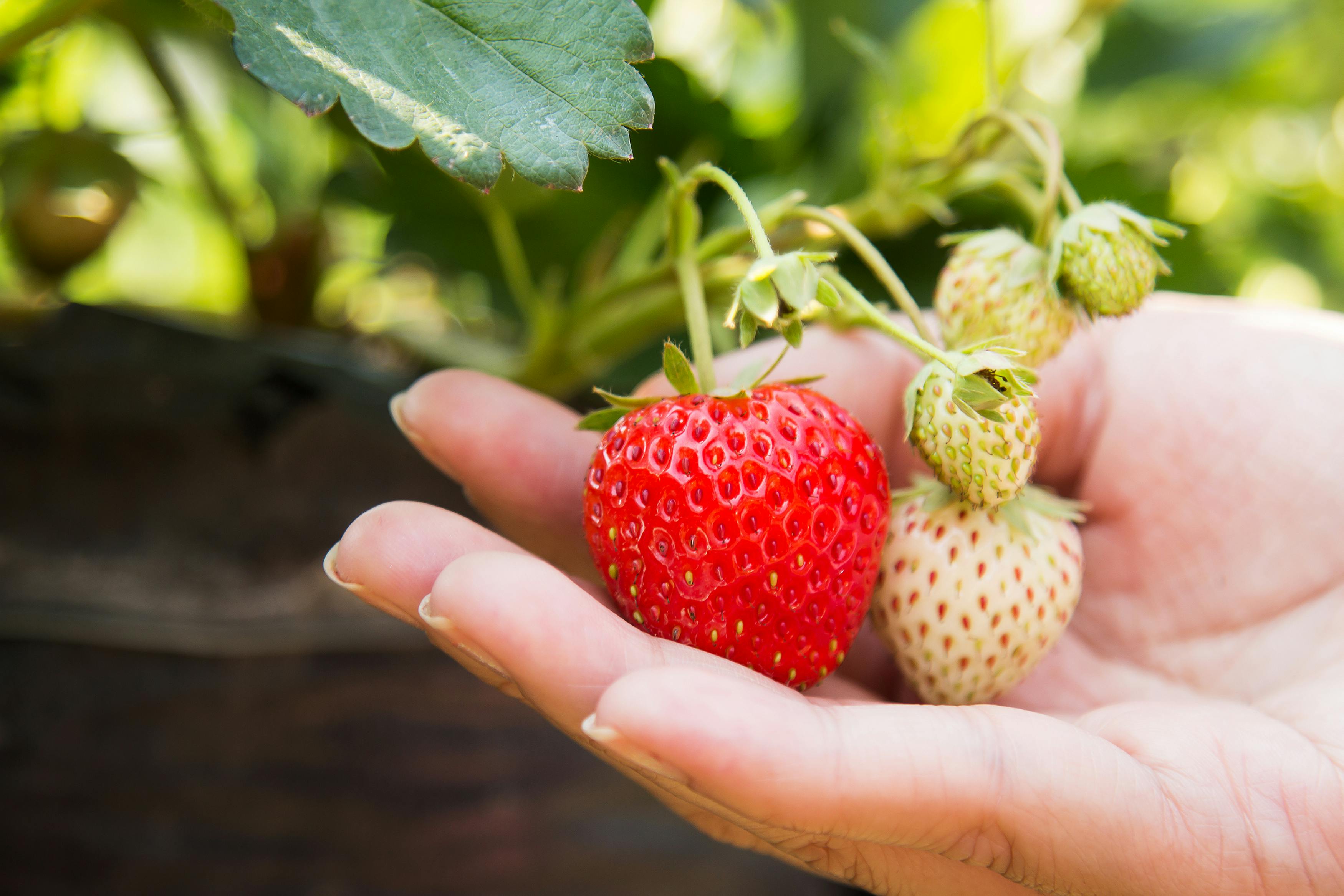Strawberries are one of the most popular fruits, and if you want to make them even sweeter, then you have come to the right place. In this article, we will discuss some tips on how to make your strawberries grow sweeter. We will look at the different factors that affect the sweetness of strawberries and how you can use them to your advantage. These tips will help you get the sweetest strawberries possible from your garden or local farm stand. So, let’s get started!To make strawberries grow sweeter, it is important to ensure that the soil they are planted in is well-draining and nutrient-rich. Additionally, strawberries need about 8 hours of full sun each day and should be watered regularly. Planting them in an area where they will get good air circulation can also help to make them sweeter. Feeding the plants a balanced fertilizer every three weeks can also help to make them taste better. Lastly, removing any flowers that form during the first season will allow the plant to focus its energy on producing bigger and sweeter berries for the following year.
Soil Requirements for Sweet Strawberries
Sweet strawberries require well-draining soil with a pH of 6.0-6.5 for optimal growth. The soil should also be nutrient-rich, containing plenty of organic matter such as compost, peat moss, or manure. It should be amended with nitrogen, phosphorus, and potassium to provide the necessary nutrients for the plant to thrive. If the soil is too acidic or alkaline, then it can be adjusted with lime or sulfur accordingly. Additionally, it is important to make sure that the soil has good drainage so that excess water does not sit on the roots and cause them to rot.
For best results, sweet strawberries should be planted in raised beds or containers filled with a mixture of loam, compost, and peat moss. This will help ensure that they have access to adequate aeration and drainage while also providing them with all of the necessary nutrients they need to produce sweet berries. Mulching around the plants will also help keep weeds down and maintain moisture levels in the soil so that your sweet strawberries thrive throughout their growing season.
Selecting the Right Variety of Strawberry
When it comes to choosing the right variety of strawberry for your garden or farm, there are a few important factors to consider. First and foremost, you’ll need to decide which type of strawberry works best for your climate and soil conditions. Different varieties of strawberries thrive in different environments, so it’s important to do some research before settling on a specific variety.
It’s also important to think about the size and flavor of the berries you’d like to grow. Certain varieties produce large, sweet-tasting berries while others produce smaller, tart ones. Different types also have different levels of disease resistance and ripen at different times throughout the growing season.
If you plan on using your strawberries for canning or other preservation methods, then you’ll want to choose a variety that produces large fruits with a high sugar content. If you prefer fresh eating strawberries, then look for ones that are small and sweet.
Finally, be sure to select a variety that is suited for your local climate and soil type. Strawberries require plenty of sun and water in order to thrive, so make sure that your chosen variety is well-suited for your region before planting. With a little bit of research and careful consideration, you can easily find the right variety of strawberry for your needs.
Proper Watering for Sweet Strawberries
Watering strawberries is essential for producing sweet, juicy berries. Strawberries need 1-2 inches of water a week, either from rainfall or irrigation. When watering strawberry plants, apply the water slowly and evenly to the soil around the plants. Soaker hoses and drip irrigation systems are great tools for applying the right amount of water. Avoid wetting the leaves as this can cause disease and can reduce berry quality.
It is important to check soil moisture levels before watering. If the top inch of soil is dry, it’s time to water. Sandy soils tend to dry out more quickly than loam or clay soils, so sandy soils may need to be watered more often. Overwatering can also cause problems in strawberry fields including root rot and nutrient leaching. It is best to stick with a regular watering schedule and stop when plants are well saturated with moisture.
Strawberries should be watered early in the morning so that foliage has time to dry off before nightfall which helps reduce disease problems. Watering in mid-afternoon should be done in extreme cases only as it can encourage diseases due to wet leaves overnight. Monitor your strawberry plants closely throughout their growing season for signs of drought stress such as wilting or yellowing leaves which could indicate that they need additional water.
Fertilizing Sweet Strawberries
Fertilizing sweet strawberries is important for healthy, sweet, and abundant fruit production. When it comes to fertilizing strawberries, timing is key. You should fertilize your strawberry plants in early spring when the new leaves begin to appear and again at mid-season when the berries start to form. The best type of fertilizer for strawberry plants is a slow-release granular fertilizer with an analysis of 10-10-10 or 12-12-12. It’s important to apply the fertilizer evenly around the base of each plant, being careful not to get any on the foliage or berries. After applying the fertilizer, water it in thoroughly to help it reach the roots of the plants.
When fertilizing sweet strawberries, it’s important not to overfertilize as this can damage your plants and result in poor yields or off-flavor berries. It’s best to follow the instructions on the fertilizer package and use only what is recommended for your planting area. If you’re unsure about how much fertilizer to use, it’s always better to err on the side of caution and use less rather than more. Additionally, you should never apply fresh manure or compost directly onto strawberry plants as this can burn them or introduce disease into your garden.

Pruning and Training Sweet Strawberry Plants
Pruning and training sweet strawberries is essential for good yield and healthy plants. Pruning helps to encourage strong, healthy growth and the production of large, tasty fruits. Prune the stems back to two or three leaves beyond the base of the flower cluster when pruning sweet strawberry plants. This will remove any debris that could interfere with the plant’s growth, as well as encourage strong root development.
It is also important to train your sweet strawberry plants so they will produce more fruit. You can do this by tying each stem to a stake or trellis so that it grows in an upright position. This will help support the weight of the fruit as it grows, giving it room to reach its full potential. When training sweet strawberry plants, make sure not to tie them too tightly as this can damage their stems.
Once you have pruned and trained your sweet strawberry plants, make sure to give them plenty of water during dry spells and fertilize them on a regular basis. Strawberries need at least an inch of water per week during the growing season for optimal growth and production of fruit. Fertilizing with a balanced fertilizer can also help keep your sweet strawberries growing strong and producing lots of delicious fruits throughout the season.
By taking proper care of your sweet strawberry plants through pruning and training, you can ensure that they will remain healthy and productive for many years to come!
Controlling Pests and Diseases on Sweet Strawberries
Strawberries are a sweet and delicious treat that can be enjoyed year-round. However, in order for strawberries to remain healthy and sweet, it is important to control pests and diseases that can damage the fruit. There are several ways to protect strawberries from pests and diseases, including using insecticides, fungicides, and other preventive measures.
Insecticides are chemicals that kill or repel insects. These chemicals can be applied directly to the strawberry plants or through the use of sprays or dusts. Applying insecticides regularly will help to keep the strawberry patch free of insects such as aphids, mites, thrips, earwigs, and whiteflies. Fungicides are also important for controlling fungal diseases such as powdery mildew and gray mold. Fungicides should be applied at least twice a season in order to keep fungal diseases at bay.
It is also important to practice good cultural practices when growing strawberries in order to prevent pests and diseases from taking hold. This includes rotating crops every year, removing weeds regularly, keeping the area around the strawberry patch free of debris that could harbor pests or disease-causing organisms, irrigating in a way that does not promote fungal growth (such as overhead irrigation), and pruning plants correctly.
Finally, it is always advisable to inspect the strawberry patch frequently for signs of pests or disease. If any signs are noticed early on, it is important to take immediate action in order to prevent further damage from occurring. Taking these steps will help ensure that your strawberries remain sweet and healthy all season long!
Checking for Maturity and Harvesting Sweet Strawberries
It is important to check the maturity of strawberries before harvesting. Strawberries are usually ready to be picked when they are bright red and firm. To make sure that they are ripe, gently press the strawberry with your thumb. If it yields to slight pressure, it is ready to harvest. When picking strawberries, be gentle and take care not to bruise or damage them.
It is best to harvest strawberries in the morning or late afternoon when they are cool and have had a chance to absorb moisture from dew. If you wait until midday when the sun is highest in the sky, you run the risk of exposing your strawberries to too much heat which can cause them to become soft and overly sweet.
When harvesting, try not to get any green berries as they will not ripen further once picked. Also be sure to discard any moldy or discolored berries as these can spread disease that affects other plants in the strawberry patch.
Once harvested, strawberries should be kept cool until you are ready to eat them or use them in cooking or baking. If you plan on preserving your berries for later use, make sure they are completely dry before storing them in a sealed container in the refrigerator for up to 5 days.

Conclusion
Growing sweet strawberries requires knowledge and patience, but it is possible to do with some hard work. Start by choosing the right variety for your area, as each cultivar will have different needs. Planting the strawberry crowns in well-draining, nutrient-rich soil and providing plenty of sunlight and water will help to ensure that your strawberries grow successfully.
Fertilizing during the growing season, removing runners as they appear, and removing any diseased or dead plants can also help encourage better production of sweet strawberries. Finally, harvesting the berries when they are ripe will ensure that you get the sweetest-tasting fruit possible. With a little bit of effort and know-how, you can have a crop of sweet strawberries in no time!



